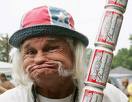Daniel Moore is a famous artist who has devoted his painting career to depicting scenes from Alabama football games. Some dim wit at the University of Alabama decided that A) this violated the University’s trademarks (because Moore painted the players in their crimson and white uniforms) and B) that it might be a good idea to sue him for trademark infringement.
Moore denied violating trademark laws and claimed his art is speech protected by the U.S. Constitution.
U.S. District Court Judge Robert Propst, in an opinion issued Monday, rejected the university’s argument that Moore’s paintings violated trademark law by showing Alabama players in their crimson and white uniforms.
“This court concludes that the depiction of the uniforms in the paintings is incidental to the purpose and expression of the paintings,” said Propst, a University of Alabama graduate. He said the purpose of the paintings was to “artistically depict and preserve notable football plays in the history of University of Alabama football.” (source)
Alabama… come for the incest. Stay for the morons.

 By RSS Feed
By RSS Feed
My only problem Marc is how else can Alabama protect their trademark. If they don’t police their mark, the run the danger of abandonment; if they license, the could get dicked over for naked licensing.
I think the law is the problem here. Abandonment law doesn’t have great guidance one when you can be a nice guy and let this stuff fly.
That all assumes Alabama wants to play this as nice guys, and we all know that can’t be right.
I just fail to see how it could be infringement in the first place — and thus, how could it be abandonment?
Marc, I completely agree. If there is no infringement, then their can be no abandonment for failure to pursue infringers. And there was no infringement here. The University really needs to have its head examined for pursuing this case in the first place. I’d like to know who advised them that this would be a good idea….
Thilo
the whole “vigorous defence” of a mark was invented by trademark lawyers so what should we expect ?
I’d say a simple safe middle ground that even a university in Alabama could figure out would be sending a letter and letting the the other party reply with an affirmative defence and dropping anything that made even remote sense. It would be annoying but only mildly annoying.
I’m slightly confused. I am not a lawyer, but what is the difference between what Mr. Moore does and what sports photographers do? It is basically the same act, but captured in a different medium, correct? Do sports photographers have to get clearance and pay royalties for photos sold to newspapers etc? I didn’t think this was the case. Thank you very much for your time,
Such an approach would be completely reasonable. If someone later claimed the “but you let Daniel Moore do it” defense, then you pull the letter out of the file and say “we tried, he resisted, we let it drop.”
The Tide may be following the lead of the Univ. of Texa Longhorns who sued a t-shirt maker for using a “saw ’em off” logo parody of the Horns’ logo. That suit got them a swarm of bad publicity, front page of USA Today, and settled quickly, so not necessarily a smart move to follow their lead. I think that the in-house lawyers at universities have too much time on their hands.
The Tide are also likely following the lead of the University of Kansas who sued a local t-shirt shop for infringement due to its use of blue and the word KANSAS. The University won. I’m not kidding.
I am not aware of any USPTO goods and services classification that would cover paintings, these are usually covered under copyright. Have you seen a classification that they could have used to include trademark protection for the classification of paintings?